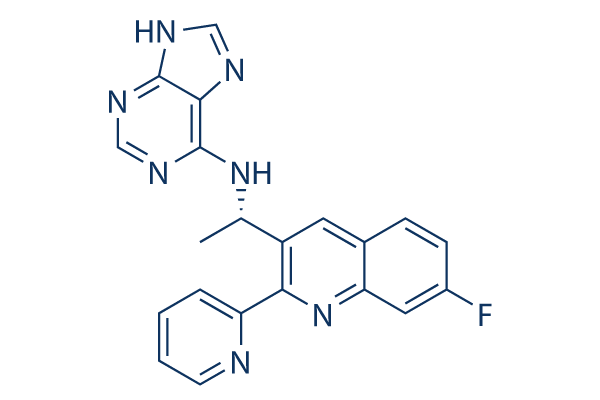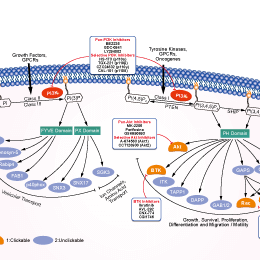
- Bioactive Compounds
- By Signaling Pathways
- PI3K/Akt/mTOR
- Epigenetics
- Methylation
- Immunology & Inflammation
- Protein Tyrosine Kinase
- Angiogenesis
- Apoptosis
- Autophagy
- ER stress & UPR
- JAK/STAT
- MAPK
- Cytoskeletal Signaling
- Cell Cycle
- TGF-beta/Smad
- DNA Damage/DNA Repair
- Compound Libraries
- Popular Compound Libraries
- Customize Library
- Clinical and FDA-approved Related
- Bioactive Compound Libraries
- Inhibitor Related
- Natural Product Related
- Metabolism Related
- Cell Death Related
- By Signaling Pathway
- By Disease
- Anti-infection and Antiviral Related
- Neuronal and Immunology Related
- Fragment and Covalent Related
- FDA-approved Drug Library
- FDA-approved & Passed Phase I Drug Library
- Preclinical/Clinical Compound Library
- Bioactive Compound Library-I
- Bioactive Compound Library-Ⅱ
- Kinase Inhibitor Library
- Express-Pick Library
- Natural Product Library
- Human Endogenous Metabolite Compound Library
- Alkaloid Compound LibraryNew
- Angiogenesis Related compound Library
- Anti-Aging Compound Library
- Anti-alzheimer Disease Compound Library
- Antibiotics compound Library
- Anti-cancer Compound Library
- Anti-cancer Compound Library-Ⅱ
- Anti-cancer Metabolism Compound Library
- Anti-Cardiovascular Disease Compound Library
- Anti-diabetic Compound Library
- Anti-infection Compound Library
- Antioxidant Compound Library
- Anti-parasitic Compound Library
- Antiviral Compound Library
- Apoptosis Compound Library
- Autophagy Compound Library
- Calcium Channel Blocker LibraryNew
- Cambridge Cancer Compound Library
- Carbohydrate Metabolism Compound LibraryNew
- Cell Cycle compound library
- CNS-Penetrant Compound Library
- Covalent Inhibitor Library
- Cytokine Inhibitor LibraryNew
- Cytoskeletal Signaling Pathway Compound Library
- DNA Damage/DNA Repair compound Library
- Drug-like Compound Library
- Endoplasmic Reticulum Stress Compound Library
- Epigenetics Compound Library
- Exosome Secretion Related Compound LibraryNew
- FDA-approved Anticancer Drug LibraryNew
- Ferroptosis Compound Library
- Flavonoid Compound Library
- Fragment Library
- Glutamine Metabolism Compound Library
- Glycolysis Compound Library
- GPCR Compound Library
- Gut Microbial Metabolite Library
- HIF-1 Signaling Pathway Compound Library
- Highly Selective Inhibitor Library
- Histone modification compound library
- HTS Library for Drug Discovery
- Human Hormone Related Compound LibraryNew
- Human Transcription Factor Compound LibraryNew
- Immunology/Inflammation Compound Library
- Inhibitor Library
- Ion Channel Ligand Library
- JAK/STAT compound library
- Lipid Metabolism Compound LibraryNew
- Macrocyclic Compound Library
- MAPK Inhibitor Library
- Medicine Food Homology Compound Library
- Metabolism Compound Library
- Methylation Compound Library
- Mouse Metabolite Compound LibraryNew
- Natural Organic Compound Library
- Neuronal Signaling Compound Library
- NF-κB Signaling Compound Library
- Nucleoside Analogue Library
- Obesity Compound Library
- Oxidative Stress Compound LibraryNew
- Plant Extract Library
- Phenotypic Screening Library
- PI3K/Akt Inhibitor Library
- Protease Inhibitor Library
- Protein-protein Interaction Inhibitor Library
- Pyroptosis Compound Library
- Small Molecule Immuno-Oncology Compound Library
- Mitochondria-Targeted Compound LibraryNew
- Stem Cell Differentiation Compound LibraryNew
- Stem Cell Signaling Compound Library
- Natural Phenol Compound LibraryNew
- Natural Terpenoid Compound LibraryNew
- TGF-beta/Smad compound library
- Traditional Chinese Medicine Library
- Tyrosine Kinase Inhibitor Library
- Ubiquitination Compound Library
-
Cherry Picking
You can personalize your library with chemicals from within Selleck's inventory. Build the right library for your research endeavors by choosing from compounds in all of our available libraries.
Please contact us at info@selleckchem.com to customize your library.
You could select:
- Antibodies
- Bioreagents
- qPCR
- 2x SYBR Green qPCR Master Mix
- 2x SYBR Green qPCR Master Mix(Low ROX)
- 2x SYBR Green qPCR Master Mix(High ROX)
- Protein Assay
- Protein A/G Magnetic Beads for IP
- Anti-Flag magnetic beads
- Anti-Flag Affinity Gel
- Anti-Myc magnetic beads
- Anti-HA magnetic beads
- Magnetic Separator
- Poly DYKDDDDK Tag Peptide lyophilized powder
- Protease Inhibitor Cocktail
- Protease Inhibitor Cocktail (EDTA-Free, 100X in DMSO)
- Phosphatase Inhibitor Cocktail (2 Tubes, 100X)
- Cell Biology
- Cell Counting Kit-8 (CCK-8)
- Animal Experiment
- Mouse Direct PCR Kit (For Genotyping)
- New Products
- Contact Us
AMG319
AMG319 is a potent and selective PI3Kδ inhibitor with IC50 of 18 nM, >47-fold selectivity over other PI3Ks. Phase 2.

AMG319 Chemical Structure
CAS No. 1608125-21-8
Purity & Quality Control
AMG319 Related Products
Signaling Pathway
Biological Activity
| Description | AMG319 is a potent and selective PI3Kδ inhibitor with IC50 of 18 nM, >47-fold selectivity over other PI3Ks. Phase 2. | ||||
|---|---|---|---|---|---|
| Targets |
|
| In vitro | ||||
| In vitro | AMG319 inhibits anti-IgM/CD40L-induced B cell proliferation with IC50 of 8.6 nM and reduces pAkt level with IC50 of 1.5 nM. AMG319 also inhibits anti-IgD-induce CD-69 expression in HWB. [1] | |||
|---|---|---|---|---|
| Kinase Assay | PI3K Enzyme Assays | |||
| A PI3K Alphascreen assay is used to measure the activity of a panel of four phosphoinositide 3-kinases: PI3Kα, PI3Kβ, PI3Kγ, and PI3Kδ. Enzyme reaction buffer is prepared using sterile water and 50 mM Tris-HCl, pH 7, 14 mM MgCl2, 2 mM sodium cholate, and 100 mM NaCl. 2 mM DTT is added fresh on the day of the experiment. The Alphascreen buffer is made using sterile water and 10 mM Tris-HCl, pH 7.5, 150 mM NaCl, 0.10% Tween 20, and 30 mM EDTA. Then 1 mM DTT is added fresh on the day of the experiment. Compound source plates used for this assay are 384-well Greiner clear polypropylene plates containing test compounds at 5 mM and diluted 1:2 over 22 concentrations. Columns 23 and 24 contained only DMSO, as these wells comprised the positive and negative controls, respectively. Source plates are replicated by transferring 0.5 μL per well into 384-well Optiplates. Each PI3K isoform is diluted in enzyme reaction buffer to 2× working stocks. PI3Kα is diluted to 1.6 nM, PI3Kβ is diluted to 0.8 nM, PI3Kγ is diluted to 15 nM, and PI3Kδ is diluted to 1.6 nM. PI(4,5)P2 is diluted to 10 μM, and ATP was diluted to 20 μM. This 2× stock is used in the assays for PI3Kα and PI3Kβ. For assay of PI3Kγ and PI3Kδ, PI(4,5)P2 is diluted to 10 μM and ATP was diluted to 8 μM to prepare a similar 2× working stock. Alphascreen reaction solutions are made using beads from the anti-GST Alphascreen kit. Two 4× working stocks of the Alphascreen reagents are made in Alphascreen reaction buffer. In one stock, biotinylated-IP4 is diluted to 40 nM and streptavadin-donor beads are diluted to 80 μg/mL. In the second stock, PIP3-binding protein is diluted to 40 nM and anti-GST-acceptor beads were diluted to 80 μg/mL. As a negative control, a reference inhibitor at a concentration ≫Ki (40 μM) is included in column 24 as a negative (100% inhibition) control. Using a 384-well Multidrop, 10 μL/well of 2× enzyme stock is added to columns 1–24 of the assay plates for each isoform. An amount of 10 μL/well of the appropriate substrate 2× stock (containing 20 μM ATP for the PI3Kα and -β assays and containing 8 μM ATP for the PI3Kγ and -δ assays) is then added to columns 1–24 of all plates. Plates are then incubated at room temperature for 20 min. In the dark, 10 μL/well of the donor bead solution is added to columns 1–24 of the plates to quench the enzyme reaction. The plates are incubated at room temperature for 30 min. Still in the dark, 10 μL/well of the acceptor bead solution is added to columns 1–24 of the plates. The plates are then incubated in the dark for 1.5 h. The plates are read on an Envision multimode plate reader using a 680 nm excitation filter and a 520–620 nm emission filter. | ||||
| In Vivo | ||
| In vivo | In female Lewis rats, AMG319 (3 mg/kg, p.o.) inhibits the KLH-induced inflammatory response by 88%. In the transgenic (IgMm) mice, AMG319 (, p.o.) inhibits in vivo pAKT with IC50 of 1.9 nM. [1] | |
|---|---|---|
| Animal Research | Animal Models | Female Lewis rats |
| Dosages | ~3 mg/kg | |
| Administration | p.o. | |
| NCT Number | Recruitment | Conditions | Sponsor/Collaborators | Start Date | Phases |
|---|---|---|---|---|---|
| NCT02540928 | Terminated | Human Papillomavirus (HPV)|Positive or Negative Head and Neck Squamous Cell Carcinoma (HNSCC) of the Hypopharynx Oropharynx Oral Cavity Supraglottis or Larynx |
Cancer Research UK |
October 2015 | Phase 2 |
Chemical Information & Solubility
| Molecular Weight | 385.4 | Formula | C21H16FN7 |
| CAS No. | 1608125-21-8 | SDF | Download AMG319 SDF |
| Smiles | CC(C1=C(N=C2C=C(C=CC2=C1)F)C3=CC=CC=N3)NC4=NC=NC5=C4NC=N5 | ||
| Storage (From the date of receipt) | |||
|
In vitro |
DMSO : 77 mg/mL ( (199.79 mM) Moisture-absorbing DMSO reduces solubility. Please use fresh DMSO.) Ethanol : 77 mg/mL Water : Insoluble |
Molecular Weight Calculator |
|
In vivo Add solvents to the product individually and in order. |
In vivo Formulation Calculator |
||||
Preparing Stock Solutions
Molarity Calculator
In vivo Formulation Calculator (Clear solution)
Step 1: Enter information below (Recommended: An additional animal making an allowance for loss during the experiment)
mg/kg
g
μL
Step 2: Enter the in vivo formulation (This is only the calculator, not formulation. Please contact us first if there is no in vivo formulation at the solubility Section.)
% DMSO
%
% Tween 80
% ddH2O
%DMSO
%
Calculation results:
Working concentration: mg/ml;
Method for preparing DMSO master liquid: mg drug pre-dissolved in μL DMSO ( Master liquid concentration mg/mL, Please contact us first if the concentration exceeds the DMSO solubility of the batch of drug. )
Method for preparing in vivo formulation: Take μL DMSO master liquid, next addμL PEG300, mix and clarify, next addμL Tween 80, mix and clarify, next add μL ddH2O, mix and clarify.
Method for preparing in vivo formulation: Take μL DMSO master liquid, next add μL Corn oil, mix and clarify.
Note: 1. Please make sure the liquid is clear before adding the next solvent.
2. Be sure to add the solvent(s) in order. You must ensure that the solution obtained, in the previous addition, is a clear solution before proceeding to add the next solvent. Physical methods such
as vortex, ultrasound or hot water bath can be used to aid dissolving.
Tech Support
Answers to questions you may have can be found in the inhibitor handling instructions. Topics include how to prepare stock solutions, how to store inhibitors, and issues that need special attention for cell-based assays and animal experiments.
Tel: +1-832-582-8158 Ext:3
If you have any other enquiries, please leave a message.
* Indicates a Required Field
Tags: buy AMG319 | AMG319 supplier | purchase AMG319 | AMG319 cost | AMG319 manufacturer | order AMG319 | AMG319 distributor







































